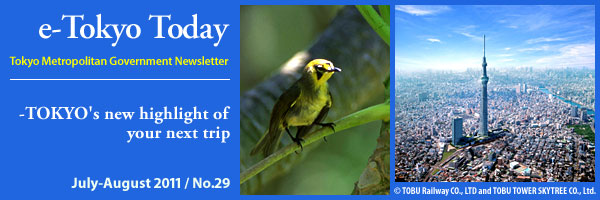
 |
|
News & Announcements
|
||
|
Tsukiji Market Tuna Auction Observation Area Reopens from July 26
The Tuna Auction Observation Area of the Tsukiji Market, temporarily closed after the Great East Japan Earthquake, will be open again to visitors from July 26. Here are some important changes regarding acceptance of visitors: Re-opening of Visits to the Tsukiji Market Tuna Auction Area and Changes to Visiting Procedures Tsukiji Market |
||
|
Tokyo Shitamachi Sightseeing Bus Resumes its Operation with New Routes
Sightseeing Bus (tokyo shitamachi bus), the route bus that covers major sightseeing spots in Tokyo, has resumed its service with three new routes from July 20. Two routes operating on weekdays start from Ueno and go through nearby TOKYO SKYTREE®, the new landmark in Sumida Ward. Then, one route continues bound for Ryogoku, and the other continues bound for Kinshicho, which is home to one of the biggest one-coin shops in Tokyo and near the old town of Kameido, known for its nostalgic atmosphere. The other route, a longer one operated on weekends and holidays, starts from Tokyo Station. Major Stops Route 1 (weekdays): Ueno Matsuzakaya - Ueno Koen Yamashita - Kikuyabashi - Asakusa Kaminarimon - Narihirabashi - Oshiage - Kinshicho Station Route 2 (weekdays): Ueno Matsuzakaya - Ueno Koen Yamashita - Kikuyabashi - Asakusa Kaminarimon - Narihirabashi - Oshiage - Ryogoku Station Route 3 (weekends): Tokyo Station - Nihombashi Mitsukoshi - Kanda Station - Ueno Matsuzakaya - Ueno Koen Yamashita - Kikuyabashi - Asakusa Kaminarimon - Narihirabashi - Oshiage - Ryogoku Station English site (to open soon) |
||
|
Applications for Tokyo Marathon 2012 Accepted during August
Tokyo Marathon 2012 |
||
|
"Galapagos Islands of the East" Becomes Tokyo's First World Heritage Site: Ogasawara Islands
|
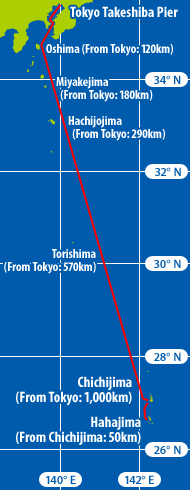 The Ogasawara Islands, located in a subtropical area 1,000 kilometers south of central Tokyo, officially belong to the Metropolis of Tokyo. These remote islands won World Heritage recognition on June 24, 2011, Tokyo's first ever World Heritage site and the fourth World Natural Heritage site in Japan. The registered area covers 6,360 hectares of land, including parts of Chichijima and Hahajima, and 1,580 hectares of the surrounding sea. The Ogasawara Islands, located in a subtropical area 1,000 kilometers south of central Tokyo, officially belong to the Metropolis of Tokyo. These remote islands won World Heritage recognition on June 24, 2011, Tokyo's first ever World Heritage site and the fourth World Natural Heritage site in Japan. The registered area covers 6,360 hectares of land, including parts of Chichijima and Hahajima, and 1,580 hectares of the surrounding sea.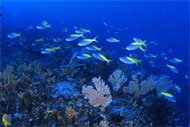 The Ogasawara Islands, consisting of more than 30 islands, have an oceanic climate with an annual average daily temperature of 23.3 degrees Celsius. The beautiful nature of the land amongst the cobalt blue ocean is indeed a paradise. Because they are far from other lands and thus home to many indigenous flora and fauna, they are called "The Galapagos Islands of the East." The Ogasawara Islands, consisting of more than 30 islands, have an oceanic climate with an annual average daily temperature of 23.3 degrees Celsius. The beautiful nature of the land amongst the cobalt blue ocean is indeed a paradise. Because they are far from other lands and thus home to many indigenous flora and fauna, they are called "The Galapagos Islands of the East." They have a lot to offer: marine activities like swimming with wild dolphins, whale-watching, diving and snorkeling in the sea with coral reefs and swarms of tropical fish, sea kayaking, and fishing. Other activities, including forest and mountain nature hikes, sunset and night tours and bird watching, are also available. They have a lot to offer: marine activities like swimming with wild dolphins, whale-watching, diving and snorkeling in the sea with coral reefs and swarms of tropical fish, sea kayaking, and fishing. Other activities, including forest and mountain nature hikes, sunset and night tours and bird watching, are also available.In addition to administrative ordinances, some organizations voluntarily set up rules for protection of the vulnerable ecosystem of the Ogasawara Islands and to control the balance between use and protection. Please confirm these rules prior to visiting the islands. 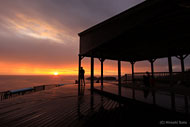 The only way to visit the Ogasawara is a 25-hour journey by boat from Tokyo, but the extraordinary beauty of the islands is sure to be worth the visit. Above all, geographical distance which allows you to leave all cares and worries behind and enjoyment of total relaxation time are irreplaceable features of the Ogasawara travel experience. The only way to visit the Ogasawara is a 25-hour journey by boat from Tokyo, but the extraordinary beauty of the islands is sure to be worth the visit. Above all, geographical distance which allows you to leave all cares and worries behind and enjoyment of total relaxation time are irreplaceable features of the Ogasawara travel experience.Access: On scheduled days, the "Ogasawara-maru" liner departs from Takeshiba Pier in Tokyo at 10 a.m. and arrives at Chichijima at 11:30 a.m. next day (a 25.5-hour trip). From Chichijima to Hahajima by the "Hahajima-maru" ferry is another 2 hours. Movie Collection from Ogasawara Visitors Tourism Bureau Ogasawara Village Tourist Association Ogasawara Kaiun Co., Ltd. Ogasawara Rule Book |
|
TOKYO SKYTREE® Opens May 22, 2012
|
|||||||||||||||||||||
TOKYO SKYTREE in Sumida Ward in eastern Tokyo reached the planned height of 634 meters on March 18. (now under construction) This 634-meter-high terrestrial digital broadcasting tower will be Japan's tallest structure and the world's tallest self-standing telecommunications tower. From the observatories, the First Observatory at 350 meters above ground and the Second Observatory at 450 meters above ground, visitors will be able to watch down on the beautiful fireworks displays during the Sumida River Fireworks Festival usually held in July (though it is put off to August 27 this year due to the earthquake). The tower will be open for business from 8 a.m. to 10 p.m. during the first year following the opening. TOKYO Solamachi®, an adjacent commercial facility of TOKYO SKYTREE TOWN, houses about 310 shops in six zones: souvenirs, fashion and fancies, restaurants, a new "shitamachi" downtown, trend shops, and food and confectioneries.
Access: Located between Narihirabashi Station (to be renovated and renamed TOKYO SKYTREE Station) on the Tobu Isesaki Line, and Oshiage Station on the Tobu Isesaki, and Keisei Oshiage train lines, and the Hanzomon and Asakusa subway lines. TOKYO SKY TREE If you want to know more about the construction, why not visit the exhibition? A special exhibition called the "Making of TOKYO SKYTREE® - Welcome to the Construction Site in the Sky" has opened at Miraikan (National Museum of Emerging Science and Innovation) in Odaiba until October 2. The state-of-the-art technology that enabled the building of the world's tallest free-standing broadcasting tower is explained. Special Exhibition "Making of Tokyo Sky Tree®- Welcome to the construction site in the sky -" |
|||||||||||||||||||||
|
How to Enjoy Tokyo This Summer
|
||||
|
Many Tokyoites assume that this summer in Tokyo will be hotter than usual, as they will have to use less air conditioning in fear of power shortages caused by the disaster after the Great East Japan Earthquake in March. However, they think this as a good occasion to pay closer attention to saving power and eco-friendly activities and enjoy the hot summer.
Traditional Cooling Methods
Modern Power Saving Methods Most companies are saving power by turning off lights, changing to LED lights, curbing the use of air conditioners, decreasing the operation of elevators and escalators, and encouraging workers to wear "Cool Biz" fashion, a new business dress code more casual than the conventional one. Under this dress code, businessmen are allowed to remove their tie and jacket. "Super Cool Biz" fashion, such as polo shirts and casual wear, are recommended at some workplaces. Some companies are allowing employees to start and end their workday earlier and so they have more leisure time starting from as early as 4 p.m. in the late afternoon, which is much earlier than usual, and save electricity at work. Other promotions to save energy are longer vacations and working from home offices. Some factories, such as in the automotive industry, are closing on some weekdays and operating on weekends to level out the use of power over the week. Leisure After 4
There are a lot in Tokyo, but one of Japan's largest beer gardens is the MORINO BEER GARDEN (Forest Beer Garden) in Jingu Gaien. Restaurant Luke's Beer Terrace on the top floor of the 47-story St. Luke's Garden building is the highest one and has a splendid view. Mt. Takao's Beer Mount, 500 meters above ground, is also very popular. The huge Beer Restaurant Garden Islands is in the garden area of the Tokyo Prince Hotel and has seating for 1,000. MORINO BEER GARDEN St. Luke Garden (Japanese Only) Beer Mount Beer Restaurant Garden Islands Natural Cooling If you want to avoid the city heat completely, a good idea is to visit one of the many waterfalls or valleys around or even in Tokyo. Hossawa Falls in the village of Hinohara is a beautiful waterfall and considered one of the 100 finest waterfalls in Japan. The great Mitoh Falls, also in Hinohara, is just a 30-minute walk on a wood-chip-filled trail from the parking lot of Tomin no Mori Forest. The hiking route in the Hatonosu Valley along the Tama River is a hiking trail in good condition and easy for people of all ages. Todoroki Valley in Setagaya Ward is surprisingly abundant in trees and clear water, even though it is close to central Tokyo. Hinohara Village Hatonosu Valley Todoroki Valley Although efforts to save power are being forced upon Tokyoites by the disaster, it is a good opportunity to find new and exciting ways to enjoy the hot summer. |
|
I Came, I Saw, I Enjoyed! : Messages from Journalists Who Visited Tokyo
|
|
Please check the comments about Tokyo and Japan from journalists after the quake.
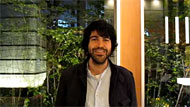 Mr. Daniel García González from Spanish magazine "Muchoviaje." (Filmed on April 22) Mr. Daniel García González from Spanish magazine "Muchoviaje." (Filmed on April 22)
Message from Mr. Daniel García González, Spanish Magazine "Muchoviaje"  Ms. Begoña Pérez Blanco from Spanish magazine "Muchoviaje." (Filmed on April 22) Ms. Begoña Pérez Blanco from Spanish magazine "Muchoviaje." (Filmed on April 22)Message from Ms. Begoña Pérez Blanco, Spanish magazine "Muchoviaje" 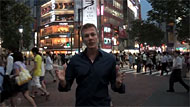 Mr. Mark Murphy from Performance Media, who publishes major travel magazines such as "Vacation Agent" and "Agent @ home," updated some videos shot in Tokyo in June 2011. Mr. Mark Murphy from Performance Media, who publishes major travel magazines such as "Vacation Agent" and "Agent @ home," updated some videos shot in Tokyo in June 2011.June 17, 2011: Why You Should Travel to Japan…and Do it Now Travel Pulse.com |
